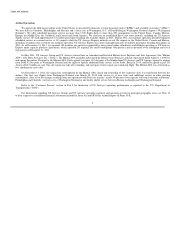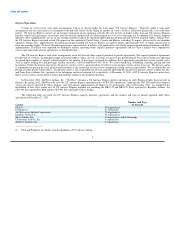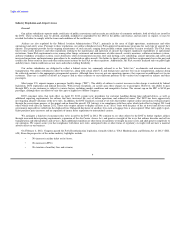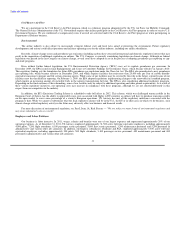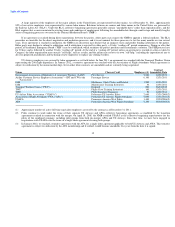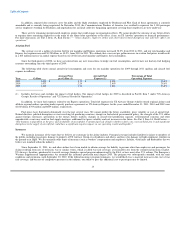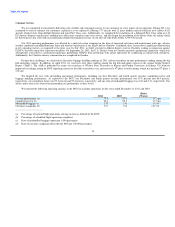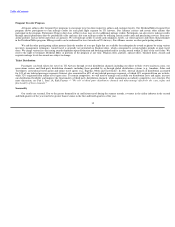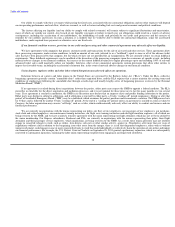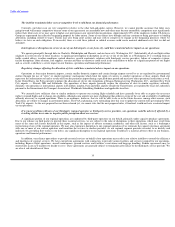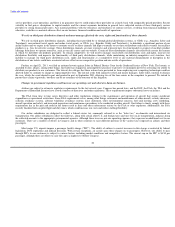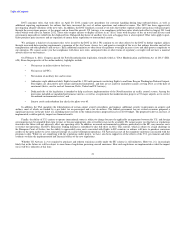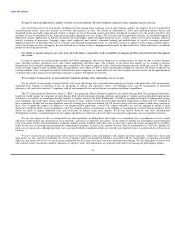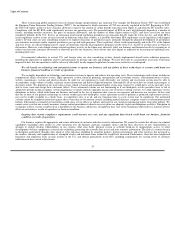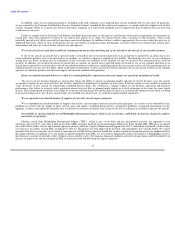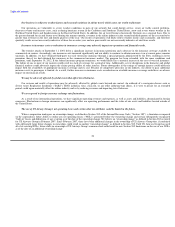US Airways 2011 Annual Report Download - page 19
Download and view the complete annual report
Please find page 19 of the 2011 US Airways annual report below. You can navigate through the pages in the report by either clicking on the pages listed below, or by using the keyword search tool below to find specific information within the annual report.
Table of Contents
Item 1A. Risk Factors
Below are certain risk factors that may affect our business, results of operations or financial condition, or the trading price of our common stock or
other securities. We caution the reader that these risk factors may not be exhaustive. We operate in a continually changing business environment, and new
risks and uncertainties emerge from time to time. Management cannot predict such new risks and uncertainties, nor can it assess the extent to which any of the
risk factors below or any such new risks and uncertainties, or any combination thereof, may impact our business.
Risk Factors Relating to the Company and Industry-Related Risks
US Airways Group could experience significant operating losses in the future.
For a number of reasons, including those addressed in these risk factors, US Airways Group might fail to achieve profitability and might experience
significant losses. In particular, the condition of the economy and the high volatility of fuel prices have had and continue to have an impact on our operating
results, and increase the risk that we will experience losses.
Downturns in economic conditions adversely affect our business.
Due to the discretionary nature of business and leisure travel spending, airline industry revenues are heavily influenced by the condition of the U.S.
economy and economies in other regions of the world. Unfavorable conditions in these broader economies have resulted, and may result in the future, in
decreased passenger demand for air travel and changes in booking practices, both of which in turn have had, and may have in the future, a strong negative
effect on our revenues. In addition, during challenging economic times, actions by our competitors to increase their revenues can have an adverse impact on
our revenues. See "The airline industry is intensely competitive and dynamic" below. Certain labor agreements to which we are a party limit our ability to
reduce the number of aircraft in operation, and the utilization of such aircraft, below certain levels. As a result, we may not be able to optimize the number of
aircraft in operation in response to a decrease in passenger demand for air travel.
Our business is dependent on the price and availability of aircraft fuel. Continued periods of high volatility in fuel costs, increased fuel prices and
significant disruptions in the supply of aircraft fuel could have a significant negative impact on our operating results and liquidity.
Our operating results are materially impacted by changes in the availability, price volatility and cost of aircraft fuel, which represents one of the largest
single cost items in our business. Fuel prices have fluctuated substantially over the past several years with jet fuel spot prices ranging from a low of
approximately $1.87 per gallon to a high of approximately $3.38 per gallon during the period from January 1, 2010 to December 31, 2011.
Because of the amount of fuel needed to operate our airline, even a relatively small increase in the price of fuel can have a material adverse aggregate
effect on our costs and liquidity. Due to the competitive nature of the airline industry and unpredictability of the market, we can offer no assurance that we
may be able to increase our fares, impose fuel surcharges or otherwise increase revenues sufficiently to offset fuel price increases.
Although we are currently able to obtain adequate supplies of aircraft fuel, we cannot predict the future availability, price volatility or cost of aircraft
fuel. Natural disasters, political disruptions or wars involving oil-producing countries, changes in fuel-related governmental policy, the strength of the U.S.
dollar against foreign currencies, speculation in the energy futures markets, changes in aircraft fuel production capacity, environmental concerns and other
unpredictable events may result in fuel supply shortages, additional fuel price volatility and cost increases in the future.
Historically, we have from time to time entered into hedging arrangements designed to protect against rising fuel costs. Since the third quarter of 2008,
we have not entered into any new transactions to hedge our fuel consumption, and we have not had any fuel hedging contracts outstanding since the third
quarter of 2009. Our ability to hedge in the future may be limited, particularly if our financial condition provides insufficient liquidity to meet counterparty
collateral requirements. Our future fuel hedging arrangements, if any, may not completely protect us against price increases and may be limited in both
volume of fuel and duration. Also, a rapid decline in the price of fuel at a time when we have fuel hedging contracts in place could adversely impact our short-
term liquidity, because hedge counterparties could require that we post collateral in the form of cash or letters of credit when the projected future market price
of fuel drops below the strike price. See also the discussion in Part II, Item 7A, "Quantitative and Qualitative Disclosures About Market Risk."
16


